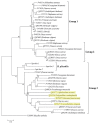Discovering genes associated with dormancy in the monogonont rotifer Brachionus plicatilis
- PMID: 19284654
- PMCID: PMC2667189
- DOI: 10.1186/1471-2164-10-108
Discovering genes associated with dormancy in the monogonont rotifer Brachionus plicatilis
Abstract
Background: Microscopic monogonont rotifers, including the euryhaline species Brachionus plicatilis, are typically found in water bodies where environmental factors restrict population growth to short periods lasting days or months. The survival of the population is ensured via the production of resting eggs that show a remarkable tolerance to unfavorable conditions and remain viable for decades. The aim of this study was to generate Expressed Sequence Tags (ESTs) for molecular characterisation of processes associated with the formation of resting eggs, their survival during dormancy and hatching.
Results: Four normalized and four subtractive libraries were constructed to provide a resource for rotifer transcriptomics associated with resting-egg formation, storage and hatching. A total of 47,926 sequences were assembled into 18,000 putative transcripts and analyzed using both Blast and GO annotation. About 28-55% (depending on the library) of the clones produced significant matches against the Swissprot and Trembl databases. Genes known to be associated with desiccation tolerance during dormancy in other organisms were identified in the EST libraries. These included genes associated with antioxidant activity, low molecular weight heat shock proteins and Late Embryonic Abundant (LEA) proteins. Real-time PCR confirmed that LEA transcripts, small heat-shock proteins and some antioxidant genes were upregulated in resting eggs, therefore suggesting that desiccation tolerance is a characteristic feature of resting eggs even though they do not necessarily fully desiccate during dormancy. The role of trehalose in resting-egg formation and survival remains unclear since there was no significant difference between resting-egg producing females and amictic females in the expression of the tps-1 gene. In view of the absence of vitellogenin transcripts, matches to lipoprotein lipase proteins suggest that, similar to the situation in dipterans, these proteins may serve as the yolk proteins in rotifers.
Conclusion: The 47,926 ESTs expand significantly the current sequence resource of B. plicatilis. It describes, for the first time, genes putatively associated with resting eggs and will serve as a database for future global expression experiments, particularly for the further identification of dormancy related genes.
Figures



Similar articles
-
Analysis of expressed sequence tags of the cyclically parthenogenetic rotifer Brachionus plicatilis.PLoS One. 2007 Aug 1;2(7):e671. doi: 10.1371/journal.pone.0000671. PLoS One. 2007. PMID: 17668053 Free PMC article.
-
Long-term survival of hydrated resting eggs from Brachionus plicatilis.PLoS One. 2012;7(1):e29365. doi: 10.1371/journal.pone.0029365. Epub 2012 Jan 9. PLoS One. 2012. PMID: 22253713 Free PMC article.
-
Thermostable proteins in the diapausing eggs of Brachionus manjavacas (Rotifera).Comp Biochem Physiol A Mol Integr Physiol. 2012 Jul;162(3):193-9. doi: 10.1016/j.cbpa.2012.02.020. Epub 2012 Feb 27. Comp Biochem Physiol A Mol Integr Physiol. 2012. PMID: 22395100
-
Progress on the usage of the rotifer Brachionus plicatilis in marine ecotoxicology: A review.Aquat Toxicol. 2020 Dec;229:105678. doi: 10.1016/j.aquatox.2020.105678. Epub 2020 Nov 7. Aquat Toxicol. 2020. PMID: 33197688 Review.
-
Facing Adversity: Dormant Embryos in Rotifers.Biol Bull. 2019 Oct;237(2):119-144. doi: 10.1086/705701. Epub 2019 Oct 25. Biol Bull. 2019. PMID: 31714860 Review.
Cited by
-
Stress tolerance in diapausing embryos of Artemia franciscana is dependent on heat shock factor 1 (Hsf1).PLoS One. 2018 Jul 6;13(7):e0200153. doi: 10.1371/journal.pone.0200153. eCollection 2018. PLoS One. 2018. PMID: 29979776 Free PMC article.
-
Molecular analysis of the cold tolerant Antarctic nematode, Panagrolaimus davidi.PLoS One. 2014 Aug 6;9(8):e104526. doi: 10.1371/journal.pone.0104526. eCollection 2014. PLoS One. 2014. PMID: 25098249 Free PMC article.
-
Dormancy in Embryos: Insight from Hydrated Encysted Embryos of an Aquatic Invertebrate.Mol Cell Proteomics. 2017 Oct;16(10):1746-1769. doi: 10.1074/mcp.RA117.000109. Epub 2017 Jul 20. Mol Cell Proteomics. 2017. PMID: 28729386 Free PMC article.
-
Comparative transcriptome analysis of obligately asexual and cyclically sexual rotifers reveals genes with putative functions in sexual reproduction, dormancy, and asexual egg production.BMC Genomics. 2013 Jun 19;14:412. doi: 10.1186/1471-2164-14-412. BMC Genomics. 2013. PMID: 23782598 Free PMC article.
-
Uncovering diversity and metabolic spectrum of animals in dead zone sediments.Commun Biol. 2020 Mar 6;3(1):106. doi: 10.1038/s42003-020-0822-7. Commun Biol. 2020. PMID: 32144383 Free PMC article.
References
-
- Kotani T, Ozaki M, Matsuoka K, Snell TW, Hagiwara A. Reproductive isolation among geographically and temporally isolated marine Brachionus strains. Hydrobiologia. 2001;446/447:283–290.
-
- Schröder T. Diapause in monogonont rotifers. Hydrobiologia. 2005;546:291–306.
-
- Nogrady T, Walalce RL, Snell TW. Rotifera. In: Dumont HJF, editor. Guides to the identification of the microinvertebrates of the Continetal Waters and the world. The Hague:SPB Academic Publishing; 1993. pp. 1–142.
-
- Lubzens E, Zmora O. Production and nutritional value of rotifers. In: Stottrup JG, McEvoy LA, editor. Live Feeds in Marine Aquaculture. Oxford: Blackwell Publishing; 2003. pp. 300–303. 17–64 and Appendix I.
-
- Ruttner-Kolisko A. Plankton Rotifers: Biology and Taxonomy. Die Binnengewasser. 1974;26/1:1–146.
Publication types
MeSH terms
Substances
LinkOut - more resources
Full Text Sources
Research Materials

